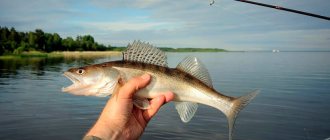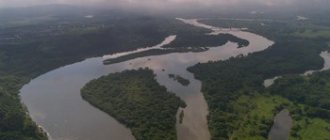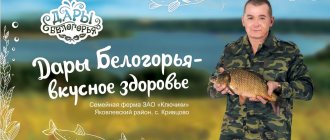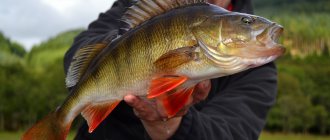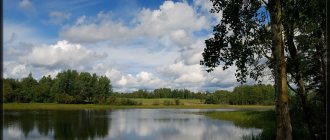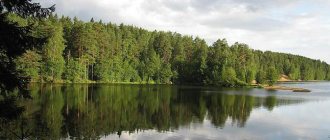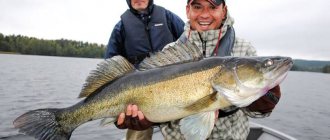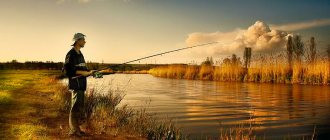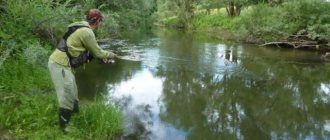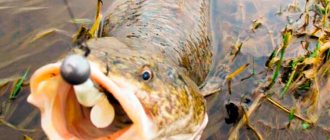What types of fish are found in the Belgorod region?
The rivers and lakes of the Belgorod region are home to many species of commercial fish. The most common of them are the carp family. In large bodies of water they often fish for carp, in smaller rivers - for carp, including mirror fish.
But the main type of fish that is common in the region is Kursk carp , which is a hybrid of Amur carp and carp. Crucian carp are often found in ponds and lakes .
golden crucian carp, which is rare today . bream are often found in calm rivers . Tench is also found - it is found in rivers and ponds with low currents and abundant vegetation.
In almost all reservoirs of the Belgorod region there are: ruffe, roach, rudd, chub, perch and silver bream . Catfish, pike perch and burbot can be found in deep rivers .
May fish bite forecast
| Weather forecast and fish bite | Calendar, from 01-07-2021 to 04-07-2021 | ||||||||||||
| Thu | PT | SB | VS | ||||||||||
| Times of Day | Day | Evening | Night | Morning | Day | Evening | Night | Morning | Day | Evening | Night | Morning | |
| Cloudiness, precipitation | Mainly cloudy | Small rain | Partly cloudy | Clear | Partly cloudy | Mainly cloudy | Mainly cloudy | Mainly cloudy | Mainly cloudy | Partly cloudy | Mainly cloudy | Mainly cloudy | |
| Temperature °C | 19 | 19 | 17 | 15 | 17 | 19 | 18 | 17 | 20 | 23 | 19 | 17 | |
| Pressure, mm. | 755 | 756 | 757 | 757 | 758 | 758 | 757 | 757 | 758 | 758 | 758 | 759 | |
| Direction, | West wind | Wind northwest | Wind northwest | Wind northwest | North wind | Wind northwest | North wind | Wind northeast | East wind | East wind | Wind northeast | East wind | |
| wind speed | 4 m/s | 4 m/s | 3 m/s | 3 m/s | 4 m/s | 3 m/s | 2 m/s | 1 m/s | 2 m/s | 2 m/s | 3 m/s | 3 m/s | |
| According to the forecast, they will bite on: maggot, mastyrka, worm, corn crucian carp | 70% | 80% | 90% | 100% | 65% | 80% | 65% | 75% | 55% | 75% | 65% | 75% | |
| According to the forecast, they bite on: corn, potatoes, peas, boilies Carp | 80% | 90% | 80% | 90% | 55% | 90% | 75% | 85% | 65% | 65% | 75% | 85% | |
| According to the forecast, they will bite on: boilies, corn, potatoes, peas, crayfish Carp | 70% | 65% | 70% | 75% | 50% | 65% | 60% | 65% | 55% | 45% | 60% | 65% | |
| According to the forecast, the fish will bite on: live bait, spinners, wobblers, and silicone baits Pike | 60% | 65% | 10% | 60% | 30% | 65% | 10% | 60% | 45% | 35% | 10% | 60% | |
| According to the forecast, they will bite on: worm, leech, small baitfish, spinners, wobblers, silicone Perch | 55% | 65% | 0% | 85% | 50% | 65% | 0% | 60% | 40% | 60% | 0% | 60% | |
| According to the forecast, they bite on: live bait, wobblers, silicone, foam fish Zander | 55% | 85% | 80% | 90% | 50% | 85% | 55% | 65% | 40% | 80% | 55% | 65% | |
| According to the forecast, they will bite on: maggot, worm Ruff | 60% | 60% | 55% | 80% | 55% | 60% | 30% | 55% | 45% | 55% | 30% | 55% | |
| According to the forecast, the fish will bite on: spinners, wobblers, cherries, corn, grasshoppers Chub | 65% | 80% | 70% | 90% | 60% | 80% | 35% | 55% | 45% | 75% | 35% | 55% | |
| According to the forecast, the fish will bite on: spinners, wobblers, silicone, grasshoppers, streamers Asp | 55% | 70% | 30% | 90% | 45% | 70% | 0% | 60% | 35% | 60% | 0% | 60% | |
| According to the forecast, the fish will bite on: maggot, fly, bread, worm, small spoon Rudd | 60% | 65% | 0% | 90% | 50% | 65% | 0% | 60% | 40% | 55% | 0% | 60% | |
| Bait: oparysh, peas, wheat, pearl barley, worm Bream | 50% | 80% | 80% | 90% | 40% | 80% | 50% | 60% | 30% | 70% | 50% | 60% | |
| Bait: sponge, dough, worm Tench | 55% | 70% | 0% | 90% | 45% | 70% | 0% | 60% | 35% | 60% | 0% | 60% | |
| Bait: no Burbot | 0% | 0% | 0% | 0% | 0% | 0% | 0% | 0% | 0% | 0% | 0% | 0% | |
| Bait: parsley, caddis fly, dough, pearl barley, wheat Roach | 70% | 85% | 0% | 85% | 45% | 85% | 0% | 80% | 55% | 60% | 0% | 80% | |
| Bait: oparysh, mastyrka, worm, corn, pearl barley Bleak | 65% | 70% | 0% | 90% | 70% | 70% | 0% | 65% | 55% | 75% | 0% | 65% | |
| Bait: sponge, leech, worm, spoon, wobbler Ide | 45% | 60% | 60% | 80% | 40% | 60% | 25% | 45% | 25% | 55% | 25% | 45% | |
| Bait: worm, live bait, mole cricket, silicone, frog Som | 20% | 45% | 70% | 55% | 55% | 45% | 75% | 60% | 40% | 80% | 75% | 60% | |
The bite forecast will help you better choose a fishing day in January, February, March, April, May, June, July, August, September. October, November, December in the Belgorod region. You may also be interested in the bite forecast for all fish in Belgorod, or fishing in the Belgorod region.
Water system of the Belgorod region
Belgorodskaya is one of the regions that belongs to the low-water regions of the Russian Federation: territorial reservoirs occupy approximately 1% of the entire surface (this is about 600 rivers and streams).
The western half of the region differs from the eastern half in its greater density and the greater flow of rivers is located in the western half of the region. Territorial rivers originate from the basins of the Azov and Black Seas.
In general, the Belgorod region is significantly poor in water resources, but on the territory of Belgorod there is the Belgorod reservoir and the bed of the largest river in the region - the Seversky Donets.
The reservoirs of the region are rich in fauna, which opens up great prospects in the field of fishing.
Rivers
The largest body of water is the Don - its basin makes up 78% of the entire regional water surface.
In second place (22%) is the Dnieper . The network of rivers in total is about 5 thousand km.
The longest of the rivers are: Vorskla, Oskol, Tikhaya Sosna and Seversky Donets.
Other rivers are much shorter: Seim, Potudan, Aidar, Chernaya Kalitva, Psel have a length of more than 25 km across the regional territory; 70 rivers – up to 25 km; the remaining part is less than 10 km.
In the Belgorod region there are 480 rivers and streams more than three kilometers long. Large rivers have clear, strong channels and gentle valleys with asymmetrically located slopes.
Small rivers are characterized by gently sloping banks, poorly developed channels and slow flows. This is due to physical and geographical conditions, which is typical for areas with southern slopes.
Summer-autumn low water runs from the end of April to the first days of May. The lowest levels occur from August to September.
The low water period is periodically disrupted by rain floods, which are often observed from June to August. Their height is about 1.5 m.
In June, the water in the rivers gradually warms up to a temperature of 20-25°C and lasts for about 2 months. Freezing of reservoirs occurs in early December.
The ice cover, which averages 0.5 m thick, lasts about 110 days. The opening of rivers occurs in the last ten days of March when the water level rises. Ice drift in spring lasts from 2 to 5 days.
Lakes
Lakes on the territory of the Belgorod region are located in peculiar lowlands and pits, at the junctions of large ravines, in places of backwaters and bays.
These are a kind of depressions on the surface of the earth that fill with water during floods and become shallow during the summer.
In the areas of Oskol, Seversky Donets, Vorskla, Tikhaya Sosna, there are several hundred large and small floodplain lakes - oxbow lakes. In the floodplain of the Oskol River north of Novy Oskol there is the longest lake, Dolgoe, the expanse of which reaches 1700 m.
Fishing in the Belgorod region has become widespread in floodplain lakes, ponds and oxbow lakes, where mainly crucian carp are found. State fisheries are breeding golden crucian carp. Sometimes tench are found in ponds.
In addition, fish such as roach, chub, perch, silver bream, ruffe, and rudd are found in large quantities in the reservoirs of the region.
Fishing is complicated by the fact that in recent years the region's fish resources have decreased significantly due to poaching, pollution and shallowing of most water bodies, which is an urgent problem for the entire region, which forced the region's leadership to take urgent measures to protect water bodies and develop fish farming.
Reservoirs
To regulate territorial surface water flow, artificial reservoirs were erected in the Belgorod region: Belgorodskoye, Soldatskoye, Morkvinskoye, Starooskolskoye, Korochanskoye, Uraevskoye. The largest of them are Korochanskoye, Belgorodskoye, Uraevskoye and Starooskolskoye.
Of particular importance in the region is the Belgorod reservoir, located on the Seversky Donets River. It was built in 1985 to provide uninterrupted water supply to the Belgorod industrial hub and improve the quality of river water.
The reservoir has a volume of 76 million m³. The hydrochemical indicators of the water in the reservoir belong to quality class 3 (moderately polluted). Recently, the quality of water composition has noticeably improved.
Ponds
The Belgorod region has many regional ponds: Belgorod ponds, Gubkin ponds, Stary Oskol ponds and other reservoirs in the region.
At the ponds you can get qualified advice and tips on fishing in local waters. Belgorod Ponds are happy to welcome guests at any time of the year.
Below is a list of paid and free ponds:
- White Well - Paid Pond. The cost of fishing is 400 rubles. day, 4 tackles.
- Velikomikhailovka - Paid pond. The cost of fishing is 200 rubles, fishing from a boat is allowed 350 rubles.
- Vladimirovka – Regular, free pond
- City decorative pond - Decorative, urban, planned pond. The cost of fishing is 150 rubles. in 3 hours.
- Znamenka - Toll Pond. The cost of fishing is 350 rubles. in 12 hours.
- Kamyshenka (snag) - Paid pond. Cost of fishing: per night 150 rubles, per day 200 rubles.
- Novoselovka - Paid pond. The cost of fishing is 250 rubles. Opportunity to catch carp from 400 to 1500 g or quite large crucian carp.
- Oskolec – Free pond, has a large number of predators.
- Popov Verkh - Paid pond. The cost is determined on the spot.
- Stepanovka, Gorshechensky district - Toll pond. The cost of fishing is 500 rubles. in half a day, 2 gears. There is a predator and silver carp.
- The “Gontarevo” tract, Smorodino village, Grayvoronsky district - Paid pond, area 2 hectares. Fish species: grass carp, carp, silver carp, weight 1-1.5 kg. Fishing time is not limited, there are no restrictions on catching fish, payment upon catching fish is 100 rubles. per kg.
- Putodan - Toll pond. The cost of fishing is 100 rubles. Crucian carp, carp and perch are caught.
- Rogovoe – Free pond. Regular fishing.
- Ryndino – Free pond, catching crucian carp.
- Serebryanka - Paid pond. Cost of fishing: from 6 to 13 – 200 rubles. for tackle, from 13 to 21 another 200 rubles.
- Sosnovka-Somovka – Free pond.
- Dry Olshanka - Paid pond. Cost of fishing: from the shore 300 rubles. for 8 hours, 3 rods, from a boat 500 rubles.
- Ukolovo – Large paid pond. The cost is determined on the spot. There are a large number of fish species: pike perch, carp, carp, grass carp, silver carp, perch, roach, bleak and tench.
- Uspenka - Paid pond. The cost of fishing is 250 rubles. per day, from the shore. You are allowed to catch 5 kg of fish. From a boat 350 rubles, the same restrictions on fishing.
- Khutor Dmitrievsky, Voronezh region - Toll pond. Cost of fishing: Morning dawn – 350 rubles.
- Evening dawn – 350 rubles.
- Night – 700 rub.
- One day – 1000 rub.
- Predator – 100 rub.
- Boat rental – 150 rub. hour.
- Own boat – 500 rub. No time limit.
- Fishing: no more than 5 hooks per person.
Daylight hours 350 rub. no more than 7 kg.
Upon presentation of your ID:
- WWII participants - free,
- Disabled people of group III – 300 rubles.
- Disabled people of group II – 200 rubles.
- Disabled people of group I – 100 rubles.
Additional services:
- Gazebo (weekday/weekend) – 300/400 rub.
- Barbecue – 100 rub.
- Bundle of firewood – 100 rubles.
Winter fishing in the Belgorod region
Fishing in winter is radically different from all other seasons; it requires a special choice of gear and more detailed preparation.
Requirements for winter fishing in the Belgorod region:
- use fishing rods that fit comfortably in your hand;
- use a nod that fits the jig correctly;
- make holes at a distance of at least two meters from each other;
- wear a warm suit, preferably one specialized for winter fishing.
Advantages of winter fishing:
- the ability to move freely around the pond;
- fish at any depth.
Some of the most popular places are:
- the Seversky Donets and Tikhaya Sosna rivers;
- Belgorod Reservoir;
- various paid ponds.
You can successfully catch:
- carp;
- carp;
- perch;
- roach;
- bream
It is more advisable to fish only with winter fishing rods and jigs. The fishing line can be simple, but strong enough, with a diameter of at least 0.1 millimeters, but no more than 0.16 millimeters, in addition, you should take a wide variety of hooks.
The main requirement for bait is its activity even in cold water. Perhaps silicone baits with a special smell can also attract attention. Important advice: only when the ice is more than twenty centimeters can you go out on it.
Fishing on the Seversky Donets
Seversky Donets is a paradise for fishermen, home to 41 species of fish.
Large and medium-sized fish in the river include pike, pike perch, catfish and bream. But first of all, the Seversky Donets is rich in small species, such as roach, rudd and perch.
Fishing on this river is good because due to the difference in the width of the riverbed (from 30 to 200 m), you can practice various types of fishing here and test your fishing skills in practice.
The coastal zones in the Svyatogorsk region enjoy prominent places of honor among fishermen. The fishing is excellent, the places are truly beautiful, the access is very convenient (nearby, a few kilometers away, is the Rostov-Kharkov-Donetsk highway).
Places that are very popular are usually busy, but the good thing about the river is that you can always find a section of the bank you like. You can always leave your car in a paid parking lot in a residential village.
In Svyatogorsk you can catch almost any type of fish that is found in the Seversky Donets. Individuals are sometimes so huge that when fishing from a bridge it is almost impossible to lift them.
The best time for fishing is summer; predator fishing is good in the fall; perch fishes very well in these places after the first frost. There are many places for “silent hunting” throughout the river - in Savinets it is possible to catch a chub.
Seversky Donets is also famous for its large abundance of pike . To catch a good pike, you have to study its habitat and habits. She does not like currents and lives in calm coastal zones, most often in bays.
Near Penka there is an opportunity to catch an asp . It can be detected during specific splashes of water, when it hunts fry and briskly chases schools of small fish. Therefore, fishermen always have a floating wobbler and spinners in their kit of essential gear.
Small pike are found near the right bank of the Donets , in the area of the bay with an island. This is a great place for new spinners. In the remaining coastal areas of the right bank, the bottom is more silty, but you can still find places where crucian carp, roach and small perch bite well.
The left bank also has a good bay near the camp site, but the fish there are gradually disappearing and soon there will be nothing to catch there. Roan Kut is the territory of poachers; when fishing, you can catch the net, break the gear, and end up in a conflict zone.
But beyond the Shchurovsky Bay there are good places for fishing, where trees grow close to the shore and many varieties of fish hide in their roots, which go deep into the rivers.
Professional indigenous fishermen often prefer fishing from a boat in the center of the river or in the coastal zone. This makes it easier to determine the behavior of the intended prey and change the throws in the desired direction. It is necessary to decide on the fishing technique, choose the right bait, bait and appropriate gear.
The predator needs to be lured by guiding along the shore, since the transverse direction is not included in its plans and can upset the fisherman.
When casting, it is recommended to direct the tackle upward, against the current to a depth of at least 2 m, slightly short of reaching the bottom.
The ideal bottom for spinning anglers is the area between the villages of Sidorovo and Tatyanovka. The chances of catching a great trophy in these places increase several times.
Fishing on Oskol
Oskol feeds the Krasnooskol Reservoir.
Its floodplain is swampy and lakes are often found in it. The riverbed is winding, the current is fast in the upper reaches, then calmer. The left bank is flat and low, the right bank is steep and high.
The Krasnooskol Reservoir is a famous place for recreation and fishing.
Currently, the number of fish in the reservoir has decreased, which affects the success of fishing.
Bream, crucian carp, perch and pike are found in Krasnooskolsky. Fishing is prohibited in the area from the river mouth to the hydroelectric dam.
The Oskol River is inhabited by roach, ide, ruffe, silver bream, and catfish. When fishing for silver bream on the river, it is better to do it at a depth in “quiet” water, using long rods (6 or more meters) or a light class feeder.
The bait is a worm and maggot; it takes the silver bream both from the bottom and a few centimeters before reaching it. When fishing for silver bream, you can catch white bream, bream, and sometimes even carp from the bottom, which may well break the tackle.
The bait for catching white bream and silver bream is usually sunflower cake or any type of porridge. Properly prepared bait can significantly affect the process and outcome of fishing.
Roach on the Oskol River is characterized by its own characteristics. She ignores the worm and is caught on maggots and dough. Good results can be obtained when fishing for caddis flies, which roaches are not averse to eating even during periods of complete absence of biting.
The places on Oskol are beautiful, the air is clean. There are trees along the banks of the river and a large number of sandy beaches, which are convenient for swimming.
The river contains a huge number of crayfish, which confirms the purity of the water, and its transparency increases the interest of underwater hunters.
Paid fishing in Belgorod for only 500 rubles per day
It will give you good emotions and help you stay healthy. Those interested can additionally rent a boat. For an additional fee, clients can enjoy a gazebo with barbecue facilities that can accommodate up to 8 people. You can also buy firewood here. You can view the territory of the base before visiting in the photo gallery.
For fishing lovers, the doors of our Fish Paradise base are open all year round.
We breed nine different types of fish:
- crucian carp,
- carp,
- silver carp,
- White amur,
- pike,
- perch,
- zander,
- catfish
Well, what would a pond be without roaches, and the client himself chooses which one he wants to catch from our pond. We are waiting for those who like to relax, sitting with a fishing rod, in the village of Gremuchiy, at the “Fish Paradise” base.
Recreation and fishing with us will not leave you indifferent. The emotions received will be remembered for a long time, and you will certainly want to return to the cozy atmosphere of the camp site again!
Fishing on the Belgorod Reservoir
To provide Belgorod with water, a reservoir with a dam was created near it on the Seversky Donets in the Shebekinsky district, in the village of Bezlyudovka.
The area of the Belgorod reservoir is 23 km², the coastline of the reservoir is 85 km long.
The reservoir is of medium depth, as it maneuvers from 3 to 14 m.
Fishing on the reservoir is possible at any time of the year. In summer, perch, roach and decent silver bream are caught here. In the Ivanovka area, near the dam and pumping station, there are good specimens of bream. Pike and pike perch are caught on the girder.
Pike perch predominates in the area from Pulyaevsky Bay to the Arcadia camp site. Less common are ide, rudd, carp, chub and gudgeon. Catfish are very rare. The most common prey is pike and perch.
In summer, fishing begins in mid-spring, when large schools of silver bream, roach and bream come out onto the warmed shallows. The main equipment for catching them is considered to be a float rod with a worm, caddis or bloodworm attachment.
At the beginning of summer, bream and carp begin to be caught using a worm, steamed pearl barley, canned corn, dough or boiled potatoes on a donk, feeder or classic fishing rod.
The area must be pre-fed; when fishing, small portions of complementary food are recommended to be added to the water. Silver bream, roach and crucian carp may also approach such a place.
Fishing for perch, pike and pike perch is mainly carried out using spinning rods. In this case, artificial baits (wobblers, twisters, spinners) or live bait are used. Small-sized catfish and decent perch bite on fish made of foam rubber and silicone.
Small fish (crucian carp, topfish, perch or roach) are used as live bait; they are caught using circles and girders, and catfish are caught using quok or donka baited with a mole cricket larva or a crawler.
Pike fishing is prohibited in April. From May 1 to June 10, fishing is prohibited in spawning areas, except for fishing with one rod, no more than 2 hooks outside the spawning grounds.
The fish come to spawn in the areas of villages such as Rzhavets, Malaya Pristan (in Karnaukhovsky Bay), Olshanets, Solomino, Toplinka, Ivanovka, Pristen and in the area of Pulyaevsky Bay.
There is also a limit on the length of fish caught. For pike perch the limit is 30 cm, for pike – 32, for catfish – 60, and carp – 40 cm.
In winter, fishermen set up unique houses made of foam plastic on the ice, use battery power for lighting, and catch fairly large bream with bloodworms during the day and at night, after feeding the planned fishing spot.
The holes are drilled wide, the fishing line is used from 0.2 mm, the sinker is about five grams.
It is possible that fish weighing up to 1.5 kg may bite, so it is preferable to use a size 6 hook. The bait used is a jig and jig head. It was revealed that larger bream are caught at night than during the day.
Favorite places for fishermen are in the areas of the pumping station near the village of Olshanets, at the Maslovaya pier and the village of Solomino, and you can go for perch right on the territory of Belgorod from the station.
The wintering pit on the Belgorod Reservoir is located 500 m from Dalniye Peski in the direction of Zmeinaya Polyana. Fishing is prohibited on it from October to the end of April.
Reservoirs of the Belgorod region
Belgorod reservoirs belong to the basins of the Azov and Black Seas, but the region itself is considered low-water. The reason for this is low rainfall and difficult terrain, due to which lakes, rivers and swamps occupy only about 1% of the total territory. In total, there are about 500 small rivers and streams in the region, the largest of which are located in the northwestern part (Vorskla, Northern Donets, Psel, Vorsklitsa). The relatively large rivers Oskol, Chernaya Kalitva, Tikhaya Sosna and Valuy flow in the eastern part. In total, the length of rivers in the region is 5 thousand kilometers. There are also 4 reservoirs and just over a thousand ponds in the region.
Features of fishing in the Belgorod region
Although there are not so many reservoirs in the region, they are all very rich in fish, which annually attracts thousands of amateur fishermen to Belgorod. Floodplain lakes, ponds and oxbow lakes, where crucian carp are found in large numbers, are very popular. In April, the fishing season for pike and pike perch begins, and the pike population has grown so much in recent years that specimens weighing up to 4 kilograms, and sometimes trophy fish weighing up to 8 kilograms, are often caught on the hook! Large pikes bite better on live bait, but small ones can also be caught on artificial baits. Perch is poorly caught in the spring, but by summer it begins to bite actively - it can be caught with a spinning rod or with “circles” with bait in the form of a verkhovka (small fish).
One of the most convenient places for fishing is the Belogorodskoye Reservoir, located a few minutes drive from the center of the region (by the way, the reservoir is especially popular in winter due to its good catch). Also in Belgorod there are a number of paid reservoirs stocked with fish - this is a decorative pond in the city of Gubkin, reservoirs Kuzkino, Znamenka, Kamyshenka, etc. The pond in the Gontarevo tract near the village of Smorodino is home to carp, silver carp, grass carp and whitefish. Separately, it is worth noting the Korochanskoye Reservoir, which is home to carp, carp, pike perch, grass carp, perch, silver carp, bleak, tench and roach.
To go fishing in the Belgorod region, you can use our catalog! Here are collected offers from tourist and fishing bases, as well as fishing guides who are ready to take you to the most catchy places. Just choose the right offer, contact its author directly and go on an unforgettable fishing trip!
Fishing on the Korochansky reservoir
The Korochanskoe reservoir is located in the Belgorod region on the Korocha River.
It is located near Borisovka, Stary Oskol and Belgorod. Its volume is 6.8 million m3.
This place is one of the most popular spots among local fishermen.
The reservoir provides water for industrial facilities, agricultural irrigation and fish farming for sale.
The reservoir has a high level, the transparency of fresh water is moderate, and there is almost no current. The Korochanskoe reservoir has a sandy bottom.
The Reservoir has a good and constant bite; tourists, avid fishermen, and lovers of sports and cultural recreation come here.
The reservoir is home to many species of fish, the most common of which are: grass carp, perch, carp, crucian carp, carp, pike perch, pike and silver carp. Broad-toed crayfish also live here. Fishing is allowed from the shore and boat.
You can pitch a tent on the shore or stay in a hunter’s and fisherman’s house. On the shore there is a beach with grounds for volleyball, football and children. Any vacationer can find his own outlet and have a good time at the reservoir.
Fishing on the lakes
There are few lakes in the region, compared to other regions, and most of them are extremely small.
Characteristics of lakes in the Belgorod region:
The most famous among fishermen are:
Lake Dolgoye is shallow and very narrow, but due to its high oxygen content, it promises a rich catch regardless of the time of year.
Good fishing from spring to autumn:
The advantage of fishing on this reservoir is the ability to fish equally successfully from the shore and from a boat. The gear can be any, but a spinning rod or a feeder is better; it is more advisable to take bloodworms or earthworms as bait.
In winter, the reservoir freezes quite quickly; people can fish from the ice only with winter fishing rods. More often pike bite on live bait.
Lakes in the valleys of Tikhaya Sosny and Oskol. In this area there are small lakes in which you can often catch:
In spring, summer and autumn, you should fish from the shore using a float rod; maggots and worms are ideal as bait.
In winter, pike mostly bite, and they are caught from the ice. Experienced fishermen use jigs and active live bait.
Important advice: on small lakes it is wiser to make several holes, in which case the probability of catching fish is greater.
